Genre: Action Developer: Novotrade Publisher: Sega Players: 1 Released: 1993
Ecco the Dolphin leaped out of the ocean in 1992, with more versions than we might usually think of. The Genesis cartridge is the original, followed by the enhanced version for Sega CD, and the 32-bit version for Windows personal computers. There’s also 8-bit Ecco for Master System, which was ported with better colors onto Game Gear. So, that’s five versions of Ecco the Dolphin, but Japan also received a sixth and seventh unique version of Ecco for its own Mega Drive and Mega CD. While its CD version is very similar to that seen in the rest of the world, the Japanese cartridge has some exclusive updates, so we can’t let it slip through the cracks of the sea floor!
Online information about this version is inconsistent, probably because most folks outside Japan have never played it. Most might not even realize that Japan received a different cartridge at all, since the rest of the world received the same original version (released for Europe and North America, etc.). At first, the fact that Japan got a different version might seem to suggest that it got the first version, as some games came out first in Japan, before the rest of the globe. However, that’s not the case, and Ecco is a European title, released first in Europe (summer of 1992), then five months later in the US (December ’92). Finally, Japan received its version seven months later, in July ’93.
The Sega logo has a sonar-cry, just to indicate that this version is new. The title screen is in English and looks the same as other versions. Stage title screens are also in English, but the message-screens are in Japanese. I can’t read it, but the Japanese characters look beautiful, and the characters spin and swirl around the screen, more than the English text (in the original cart).
The beginning limbo area surprisingly offers signs that define each choice: NEW GAME or PASSWORD. In every other version, this beginning area is vague, with nothing but the choice of two tunnels to swim through. The signs add clarity to an area that normally introduces us to the vagueness and mystery of the series. This version uses a new set of passwords, and the entry screen has a nice new touch; if we enter a wrong password, we hear the Vortex Queen chewing her monstrous jaws! The new pause screen has the word PAUSE floating in the middle of the screen and pausing now includes the music fading out softly. Later when we resume, the music slowly fades back in. It’s nice, but I can’t imagine anyone was dissatisfied with the pause functions before. And I actually miss the ability to play the music while it’s paused, as I always loved doing that.
The code for debug mode is the same, and the debug menu now has an underwater background (instead of just overlapping the gameplay screen as it used to, often with glitches in the scenery that was being overlapped). The order of stages in the debug menu has been changed, so the same number will pull up different stages in each version of Ecco. The order is better in the Japanese version, because it matches the actual stage progression, whereas the original cart has the stages out-of-order in the debug menu. Level-select also has a new quirk. If we use it immediately upon starting the game (i.e. before that big event in Home Bay), we will be stuck with that same first song, as we skip ahead. I interpret this musical quirk as intentional, a small discouragement against level-skipping around, and it’s an encouragement for us to legitimately play through the adventure. (Also, it makes little difference, because the quirk goes away if we just trigger that event in Home Bay first, before we start level-skipping around.)
There might be some more small, improved details, which are difficult to pinpoint in the murky depths of the ocean. I found a webpage on Steam that lists a few such changes, which are hard to verify, or even notice in the first place (click here for that list). The unnamed author reports that the Japanese version fixes certain bugs and glitches… but I’m not sure what that would refer to, other than the debug screen that I described above. It’s also said that the difficulty is toned-down in general. Apparently, there might be fewer enemies and they don’t re-spawn as much, but those things are hard to really tell for sure. That list also made me realize that there’s a new easy mode, if we enter the password EASY. It cuts out a few stages, to make the game shorter, and the last stage repeats endlessly. It’s kind of interesting to know, but I can’t imagine anyone really getting into this new EASY mode.
The big difference of the Japanese version is that it actually contains one completely exclusive stage, which is not found anywhere else: The Stomach! But first, there are four “semi-exclusive” stages to mention. These are stages which are not quite exclusive to this release, but they’re exclusive versions of these stages, found only in the Japanese cart. The first such stage we’ll find is Open Ocean, which is a stage that already appears in all versions of Ecco, but only the Japanese cart has a crazy new song for this stage, which is not heard in any other version. The song sounds panicky and is not a great song, but it’s just the first exclusive version of a stage that we see (the only other place this song can be found is the sound test of the original cartridge, interestingly enough).
A few stages later, we find an exclusive version of Open Ocean 2. Like the first Open Ocean, this new stage serves as another transition between different geographical regions. The first time Ecco swims through Open Ocean, in all versions, he is voyaging from the tropics up to the frozen north pole. Open Ocean 2 adds his voyage from the Arctic, back home to the tropics. I appreciate the logical inclusion of his voyage home, because in the original cart, it jumps too abruptly from the arctic straight to the tropics. (Both Open Oceans are the same stage, just flipped backwards: Ecco first swims right, to go to the arctic. Later, he swims left through the mirrored Open Ocean 2, to go back home.) While the Genesis original cart does not have Open Ocean 2, the CD version does. So, both the CD and the Japanese cart have this stage as a nice addition to the original title. It’s the music which makes both versions of this stage unique and exclusive to their particular version of Ecco the Dolphin. The Japanese cart has the only version of this stage, which uses the song that we normally hear in the first Open Ocean. The CD version features completely new music, altogether.
A semi-exclusive stage which is actually quite improved, is Cold Water, which has a beautiful new song that will not be heard in any other version! The stage, though, is present in every version of Ecco the Dolphin, as the ice-world where we find Big Blue, the giant blue whale who shares his knowledge and wisdom with us. The beautiful new song makes this a great, exclusive version of Cold Water (this song can also be heard in the sound test of the original cart, but nowhere else). Finally, the last “semi-exclusive” stage is The Machine, which has the same music as ever but which has a few changes in its stage design. I’ll describe those changes further down in the review.
And so the one fully-exclusive stage is the Stomach, which is not to be found in any form, anywhere other than the Japanese Mega Drive cart! We all know the Vortex Queen, in our dark memories of the final boss fight. The giant alien bitch has eaten Ecco’s whole family. She sends her drones after Ecco, as he must attack her eyes and her jaw until she pukes out all the ocean life she has eaten! The dramatic fight includes her trying to pull Ecco into her mouth and eat him too. Really, I can’t believe how disgusting and disturbing it sounds, when it’s written out!
If Ecco dies during the final boss fight, we’re used to starting over at the previous stage. Welcome to the Machine. But surprisingly, here the Queen never sends us to the Machine. Instead, dying from overall damage will result in simply restarting the final boss-fight. And if Ecco dies from the Queen actually eating him, he’ll be sent to her stomach, which is not the biological, gastrointestinal nightmare I had been expecting. Instead, the Stomach is like the Machine, which seems to indicate that the Vortex have metal technology built inside their biological bodies. Just chew on that! the Stomach looks like the Machine, just without auto-scroll, plus it has a new mysterious background and aggressive new enemies. We see a new species of jellyfish swimming next to regular jellyfish, but none of them are aggressive. The deadly new enemies are… Crystals! After a whole adventure of relying on the loving-kindness of crystal-Glyphs, their relatives shoot after Ecco, stabbing him with their points! These hateful crystals are strange enough that they almost seem like place-holder sprites. On the other hand, these unique enemies are found only here in this last stage ever added, which could suggest that they’re just a new enemy added for a new, extra stage. It also makes sense that the Queen’s body would contain unique enemies. These crystals are attacking Ecco like our bodies’ white blood cells attack intruding germs. As the crystals charge at Ecco, his sonar pushes them away. This specific enemy behavior is found nowhere else in the title, or even the series, as far as I know. In addition to chasing us around, some of these crystals are lodged within walls that block our way. Ecco needs to destroy them, to open up that space, and swim through.
Another unique environmental danger is the presence of horizontal platforms which fall from the top of the screen, during one section of the Stomach. They cause damage but surprisingly and thankfully, these falling platforms do not crush Ecco with instant death, if he gets caught beneath them. Rather, a platform will get stuck on top of Ecco and keep causing damage, until he manages to swim out from under it, and his movements can also dislodge the platform off of him. It’s an interesting new take on falling platforms, which are so ubiquitous/universal in so many video games, but which appear in the Ecco series only once, with these unusual qualities. I don’t recall any other game with falling platforms that have these characteristics. The deadliest danger of all is the presence of moving doors which shoot up and down. They kill dolphins instantly. Since Ecco’s sprite is always slightly drifting and moving around all by itself, it’s all too easy for him to drift into a doorway and get killed, without pressing anything!
The Stomach’s stage structure is like a maze; we spend a lot of time lost and using sonar to find our way. This is in contrast to some reports online that the sonar is broken. It works fine for me, though I have to confess I’m using an emulator (Kega Fusion), as I don’t own a physical copy yet! I plan on buying a repro of the Japanese cart soon. Interestingly, the killer-crystals show up in the sonar view as large orange circles, and the fact that these enemies received their own unique symbol for the sonar view further suggests that this stage was finished and intentional, as we see it. It’s challenging and the truth is, it can be a bit of a drag, especially with the constant attacks by diamonds, and one-hit-kills anytime we drift close to those doors. The Stomach at least offers a different kind of difficulty compared to the Machine, because instead of auto-scroll being the major challenge, the Stomach is mostly difficult for its aggressive crystals, and its maze-like design. I also appreciate that it’s a logical addition to the stages, because it just makes sense that getting eaten by the Queen would send Ecco to her Stomach. Completing either the Machine or the Stomach sends Ecco back to the final boss fight.
The Machine has been upgraded with three green crystal-Glyphs as save-points, with an options screen to CONTINUE LEVEL or RESTART LEVEL (it seems to be the only stage to receive this upgrade). Moreover, the Machine’s aliens and projectiles have shifted light gray, instead of dark green, and it makes the color-scheme of the whole stage look better. During the final boss fight, the alien drones and projectiles are back to dark green, and compared to the original cartridge, the Queen requires slightly less damage to defeat her. The ending is the same, except for a few extra screens of Japanese text. I found the translation online:
Once again, the sea is filled with the sound of happiness and the steady beat of life… Sounds that reach even the farthest stars. Because of that, five distant stars now watch over the world as they shine from across the vast reaches of space. Near the constellation of Pegasus, there is a small yet brightly shining constellation… The constellation of Delphinus.
Additionally, the Stomach carries some implications that need to be considered and digested. For one thing, the mechanical/technological theme is surprising for the Stomach because the Vortex have always appeared to be biological creatures. Their whole reason for attacking Earth is their need for a food source. So, while the Vortex seem obviously biological, the Stomach shows that the Queen’s digestive track is built of metal and machinery! Some readers might think that this implication is impossible, because nowhere else is there such a suggestion. Right, but this stage’s inconsistency doesn’t mean that it should be dismissed as meaningless, nor does it mean that the stage was unfinished or undeveloped. Some folks have interpreted the Stomach as some kind of developers’ test area to experiment with new ideas, so it was never meant to be seen by the public, and its presence in the Japanese cart was purely accidental! I disagree with that interpretation. Rather, I see the Stomach as an extra stage added to the final cart release, reflecting that the developers spent a few more months throwing in their final ideas. While some might interpret the mechanical theme as discordant with its name, the Stomach. It actually makes sense for a few reasons, so let’s dive into it!
The mechanical theme is inconsistent with the Vortex’s biological appearance, but that inconsistency is not impossible. They are still biological creatures, just with machinery built into their bodies. Bio-mechanical life-forms have always existed in the realm of science-fiction, so this is really the implication of The Stomach, that the Vortex is a cyborg species. All Vortex might possess cyborg enhancements inside their bodies, or alternately, the Queen might be the only one with technological enhancements.
All this bio-machinery begs the question of who builds it? If the Vortex perform operations on their bodies and turn themselves into cyborgs, then the size-difference of the drones could account for such a bizarre project as building a mechanical digestive tract, inside their Queen’s body. The drones are so small compared to the Queen that they could just swim through her body as they build. While possible, it’s hard to imagine them carrying out advanced, high-tech operations, because everything suggests that they’re a species of primitive intelligence.
I find the most plausible explanation is that the Vortex Queen possesses self-replicating technology, which grows and multiplies itself automatically, inside her body, as she grows larger. My best guess is that at some point in her distant past, the Vortex Queen ingested the high-technology of an advanced species, which then became incorporated into her body. There’s an implicit tragedy here, of primitive brutality overcoming advanced civilization, and literally consuming it!
But if the Vortex is such a primitive intelligence, we might be wondering how they can be capable of space travel. We typically assume that they fly some kind of spacecraft, but we never see it, so we actually don’t need to assume that it’s a spaceship as we normally think of it! For example, their craft could be more of a hive-like structure which floats in space, and just passes by Earth due to its natural movements through space. The Vortex might not even steer its course intentionally. At this point, readers may realize that indeed, we’ve never seen the exterior of their ship, so it’s possible that it’s not a ship, as much as a hive. Readers will then wonder, “wait, what about the Tube, and the Machine? Don’t these stages prove that it’s a spacecraft?” Surprisingly, no, they don’t! These stages only prove the presence of sprawling machinery. The Stomach contains some of the same machinery as the Tube and the Machine, even though we’re now inside her belly, which probably means that the Queen’s body is directly attached to her ship through that same sprawling machinery! So, we might as well consider her ship as an extension of her own giant bio-mechanical body, serving as a ship/hive, with her drones living within it! This means that Home Bay’s hurricane must be created from the Queen’s body somehow. The Tube must be one of her bio-mechanical body parts and the Machine must represent swimming through her body. Because of its auto-scrolling movements and its similarity to the Stomach, I now interpret the Machine as passing through her digestive tract, albeit a mechanical digestive tract.
These conclusions also help explain why the final boss fight shows the Queen’s head floating against a black background. We don’t see her body, because… she has no body, as the ship/hive is her body, so her head must attach directly into the wall. By the time we’ve reached the Queen’s face, we’ve just swam through her whole body, to get there! All these conclusions are implied by this extra stage in the Japanese Mega Drive cartridge (if we think about it long enough).
Finally, we must also reflect that these conclusions are consistent with the inspirations of the Ecco series. The world didn’t know about it back in the ’90s, but the internet age has brought us the knowledge that Ecco’s creator, Ed Annunziata, has reported reading and being inspired by the books of John C. Lilly, a controversial scientist known for researching dolphin-intelligence in the 1950’s and ’60s. Lilly was a devoted researcher of dolphins, as well as a devoted researcher of drugs, especially ketamine, a hallucinogen that he loved after it apparently cured him of debilitating migraine headaches. Along with his dolphin research, he conducted ongoing personal research into ketamine, keeping detailed notes of his experiences. His preferred method of drug ingestion was an IV needle stuck into his arm, and he would float in an isolation tank of warm saltwater, tripping out of his mind. For whatever reason, ketamine is known for causing hallucinations themed on communicating with aliens. So, while Lilly was floating in warm water, he believed he was having conversations with aliens! He found contact with two distinct alien groups. One is good, and the other is evil, of course. He called the good aliens ECCO, an acronym for the Earth Coincidence Control Office, a benevolent group that watches over humanity. These ECCO aliens eventually replaced his personal concept of God, as he imagined them filling all the roles of the traditional concept of God. He imagined the aliens listening to our prayers, and responding by getting involved in our lives, to help us. In a 1991 interview, Lilly said, “I call God ECCO now. The Earth Coincidence Control Office. It’s much more satisfying to call it that.”
Anyway, that’s where our favorite dolphin gets his name, from John C. Lilly’s books documenting his ketamine encounters with ECCO aliens. Their eternal enemies are the SSE, the Solid State Entity, which is a species of robotic artificial life forms, hell-bent on spreading through the galaxy, destroying and consuming everything. Basically, the Vortex is Sega’s equivalent of the SSE. Thus, it’s The Stomach which ties everything together by revealing the Vortex as a cyborg species, which makes them more consistent with Lilly’s writings. His descriptions of the SSE as a robotic, mechanical species, certainly could include the interpretation that they’re a cyborg biological species, like the Vortex.
The Japanese cartridge is definitely worth playing/owning, for any big fans of Ecco the Dolphin. It won’t set the world on fire, much more than the original cartridge, but it does add some new experiences to the classic adventure, especially for those who have already spent years swimming through the other versions. Plus, it’s helpful that it clarifies the series’ consistency with John C. Lilly’s books, and the wild universe he imagined.
Scoring the Japanese cartridge might be tricky or controversial. Its improvements are small, for the most part, so most of the experience is the same as before. Someone could argue that an improved version should be more improved than this, but that’s a pessimistic view that I disagree with, especially since this was never advertised as an updated version. It was just quietly updated as a labor of love, apparently, and most of the world never even knew about it. For that reason, I won’t criticize its improvements for being modest, as they’re modest improvements to a well-loved classic.
The Japanese cart was released in 1993, right between the original cart (1992) and its sequel, Tides of Time (1994). We might then wish that the Japanese cart included more changes that we see in the later sequel, such as deleting his dolphin screech when he gets hurt, or generally improving all the graphics and colors (as we see in Tides). However, the original graphics still look beautiful. For better or worse, his dolphin screech is just part of the first title, and there’s nothing wrong with keeping it faithful to the original. If we want to play Ecco without him screeching when he takes damage, or if we want Ecco’s body to rock some neon highlights, we’ll just have to go swimming in The Tides of Time. The fact that the sequel has even better improvements does not diminish from this being the best version of the original cartridge.
The Japanese cart also needs to be compared with the Sega CD version of Ecco the Dolphin, because technically, they’re contemporaries, both released in the summer of 1993. Apparently, the CD version came out in June, and then the Japanese cart in July. However, Japan didn’t see their own CD version until 1995, so in Japan, their updated cartridge was the only 16-bit Ecco that existed, for the following two years (regardless that Americans and Europeans were already enjoying Ecco on Sega CD, during those same two years). Only the Japanese Mega Drive cart features the Stomach; plus a uniquely updated Machine (with lighter-colored enemies, and new green crystal save-points). Musically, the Japanese cart features exclusive versions of Open Ocean, Open Ocean 2, and best of all, Cold Water with that great new song. (Plus there are all those other small updates, like the new PAUSE screen, etc.).
So, this version is important, even for those who thought they had Ecco the Dolphin already covered by owning his original cart, plus the Sega CD disc. Nope, you need the Japanese cartridge too, as it’s the only version to clarify Ecco’s universe and plot in this way (by revealing the Vortex as a cyborg species), which also clarifies the series’ consistency with John C. Lilly’s books. We can keep him in mind when we’re looking for something new to read, as the Ecco series seems to implicitly recommend his books. The Japanese cartridge version is a must-have, in some form; just for a complete experience of the original title, and for a complete experience of the Ecco series. Non-Japanese speakers won’t be able to read the dialogue and messages, so this is really being recommended for those who are already very familiar with the original title, and who won’t miss reading along, in exchange for seeing and hearing the exclusive updates of this version. Whether we buy a repro, an import, or otherwise: Any fans of Ecco the Dolphin should dive into the Japanese Mega Drive version, as the best cartridge version, the next time we feel like swimming through the 16-bit simulated ocean.
The water feels fine, and better than ever!
SCORE: 10 out of 10

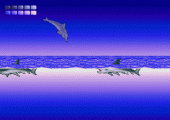
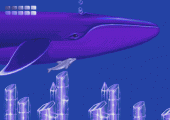
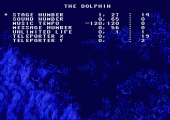
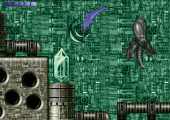
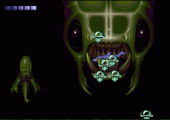
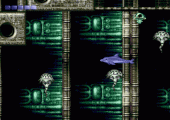
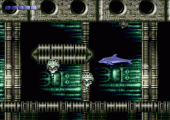
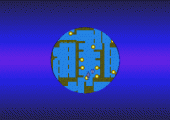
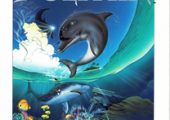
Pingback: Diferenças Regionais – DRIVE YOUR MEGA
I’ve always been fascinated from this series. I now have to research the John Lilly books, as I was not even aware. This is the very reason that I come back to these truly special Genesis offerings. What the hardware lacked in power, the level of creativity and originality more than made up for it.